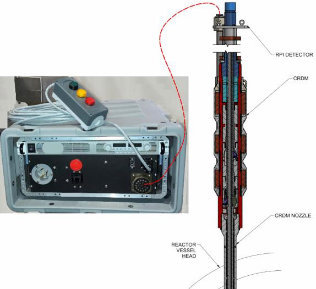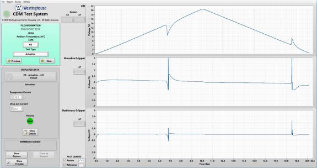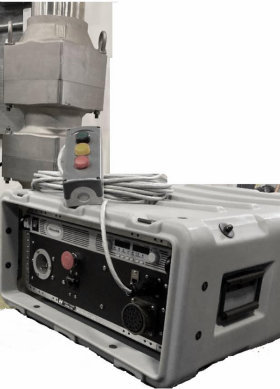Background
As the nuclear fleet ages, Westinghouse- and Combustion Engineering (CE)-designed plants are experiencing a greater number of Control Rod Drive Mechanism (CRDM)- and Control Element Drive Mechanism (CEDM)-related issues. These issues can range from improper polarity between coils; failed splices within coils; past operation of coils at excessive temperatures or current causing turn-to-turn shorts; cable and connector degradation; latch assembly wear; crud induced mis-stepping [2]; and failed latch assembly springs [1].
These problems can be exacerbated by the fact that it is difficult to diagnose electro-mechanical issues prior to reactor disassembly. Since there are currently no predictive monitoring services which can be deployed to anticipate issues in advance of experiencing malfunctions plants can experience costly unplanned downtime.
Currently, coil current traces are only recorded during stepping of the control rods during plant startup, and potentially when the plant is operating, if allowed by plant procedures. The traces are reviewed and can be transmitted to Westinghouse for analysis and diagnosis. As such, there is limited real-time feedback and limited ability to perform additional diagnostics.
Experience
As the Original Equipment Designer and Manufacturer of both Westinghouse CRDMs and Combustion Engineering CEDMs, Westinghouse has extensive experience designing, testing and troubleshooting Control Drive Mechanisms (CDMs.) This experience and extensive knowledge base has been utilized to develop our CDM Diagnostic Test System.

CDM Diagnostics Test System Connection
Description
In order to address the above issues, Westinghouse has developed a single automated system and service for the diagnostics of latch assemblies and coil stacks. The system enables all tests to be performed on the CDM system with the plant offline and offers the flexibility to perform these tests at various plant configuration stages in an outage.
Westinghouse’s CDM Diagnostic Test System and service has the ability to energize the coils, activate the CDM gripper components, and record various current/voltage response data while the plant is offline for a scheduled outage. This can be accomplished by connecting the test system to the output fuse locations of the rod control cabinet either prior to disconnecting or following reconnection of the cables from the reactor vessel head to the rod control system. This enables the validation of the entire conductor path (including cables and connectors). Alternatively, this test can be run to isolate just the CDM via a direct connection to the coil stack connector while the reactor head is in the stand.
The CDM Diagnostic Test System automatically reduces and analyzes the recorded data to find faults. The data can be trended after several screenings to predict future hardware issues as a preventative measure when a utility reports misstepping or other CDM-related actuation issues. Over time, the use of this diagnostic system will enable plants to monitor equipment health, anticipate potential issues ahead of failure, and enable tracking and trending of data.

CDM Diagnostics Software Interface
The Westinghouse CDM Diagnostic Test System offers an all-in-one tool (and service) to perform:
- Insulation resistance for each coil, to both the other coils and the shell (ground), in a controlled and repeatable manner, recording each Insulation Resistance (IR) and Dielectric Absorption Rate (DAR)
- Coil resistance under 1 amp of power, and calculation of the temperature-adjusted coil resistance, allowing for a more realistic look at coil resistance compared to standard micro-volt test equipment
- Actuation of the CDM “off-line” allowing a trace recording during coil actuation, isolated from the rod control system and influence from other rods in the subgroup, if applicable
- Automatic coil polarity determination during coil actuation testing
- Turn-to-turn diagnostics of shorts in coils, along with identifying failing splices within the coils by electrically loading the coils during the coil heating test and calculates the temperature response within the coil
- Detection and measure time and current for both engagement and dropout of CDM subassemblies, enabling the determination of relative spring force and friction of the CDM subassemblies without the need to attach accelerometers or microphones to the mechanism.

CDM Diagnostics Test System
Benefits
- Performs all tests automatically while recording and retaining test data for future analysis and trending
- Performs testing during outage, reducing risk compared to testing during power operations and allowing for corrective measures to be taken before start-up
- Integrates coil, cabling and latch assembly diagnostics in one test sequence enabling validation of non-rod control CDM health
- The only test available for accurately detecting latch assembly pole closing and opening currents and time
- Provides for potential reduction of critical path control rod startup issues by validating the CDMs during outage
- Provides the opportunity to reduce the time required to take coil health measurements, by integrating and automating these tests
- Allows for the performance of diagnostic testing on CDMs while rod control is unavailable during plant outages
Deliverables
Westinghouse is currently offering a service to perform the diagnostics testing and data review and analysis. This service can be coupled with longer term data trending and predictive analysis support, during which Westinghouse will work with utilities to identify future areas of focus for and improvement.
References
- IG-17-1, “WESTINGHOUSE CRDM LATCH ASSEMBLY LOAD TRANSFER SPRING”
- IG-05-4, “REPLACEMENT CONTROL ROD DRIVE MECHANISM OPERATIONAL EXPERIENCE”














